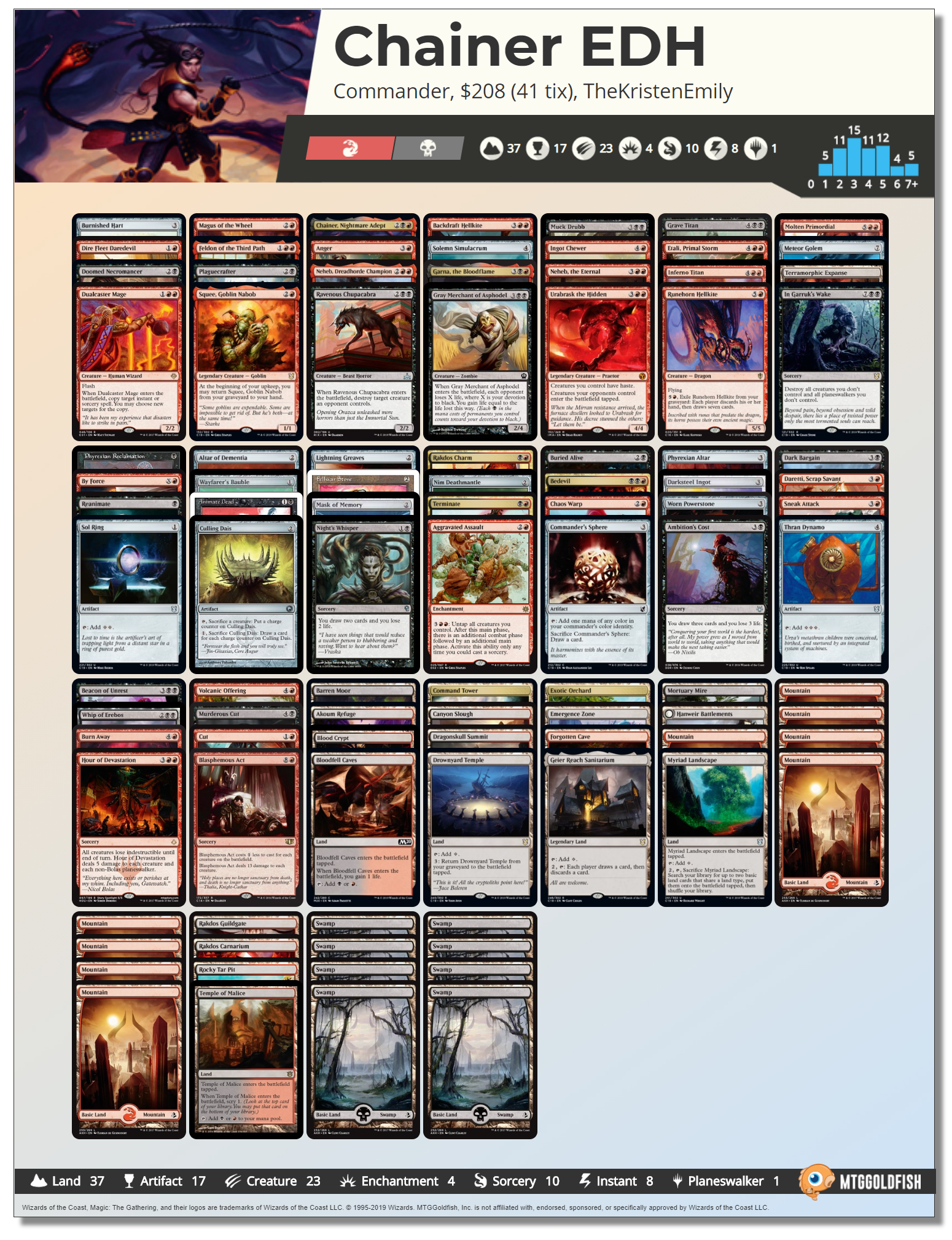In today’s edition of Legion’s Landing, Kristen picks up the Commander 2019 alternate Commander from the Merciless Rage deck, Chainer, Nightmare Adept, and takes you through a fun and resilient list.
It’s been a relatively short time since the last edition of the column, owing to the extra article I put out last week on brewing Syr Gwyn, Hero of Ashvale for Brawl. Well, it’s back to the brewing table for this week, as I visit the first of a series of planned deep dives.
A couple of weeks ago, I put out a poll to see which deck to focus on first.
https://twitter.com/TheKristenEmily/status/1176256978060042245?s=20
Although Elsha of the Infinite narrowly beat Chainer to first place, it was too close to call. Between that and having played more of Chainer lately, I decided to get some thoughts up while they were fresh. Let’s jump into it.
Chainer, Nightmare Adept
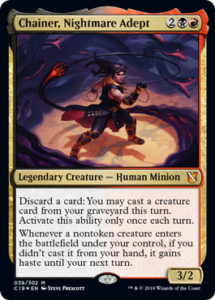
Chainer, Nightmare Adept is a really cool Commander. Being able to “jump-start” the creatures in our graveyard is a really exciting ability to have in the Command Zone, adding flexibility to a graveyard-based strategy. There’s a reason Meren of Clan Nel Toth decks are so good, and it’s the recursion on the Commander. Chainer is arguably less powerful than Meren at face value, though he can partake in a Worldgorger Dragon combo, and is definitely the right colors to abuse Murderous Redcap.
The ability that excites me the most, however, is the ability to grant haste to creatures that enter the battlefield from zones excluding your hand. This means anything we cast with Madness, from exile, from the graveyard (or an opponent’s graveyard!)—even Chainer coming in from the Command Zone—they all have haste.
I set out to build a value-based deck for this journey into Rakdos territory. So as far as infinite combos go, I haven’t included any that are truly infinite. The deck aims to tussle at mid-tier tables, with some strong recursion and control in a midrange shell that’s also capable of being the beatdown. I really enjoy decks that can turn on a heel and switch roles, and when your creatures (generally) have haste, you can do that very very consistently. One minute you’re looping Ravenous Chupacabra, and the next you’re dropping in an army with Sneak Attack. Excited? Good. Let’s unleash some nightmares.
The Deck
Let’s go over some numbers. The deck comes in at $208, which is squarely in the category of “I’d like to spend some money to play some cool cards, without going overboard.” A big chunk of the cost comes from Grave Titan, Phyrexian Altar, Sneak Attack, Reanimate, and Blood Crypt, which actually take up nearly half of the cost at $80. There’s no doubt you can build a competitive list for cheaper—and there’s some really strong cEDH builds for $20—but that’s not why either of us are here.
The deck runs 37 lands, which is about right. We curve out around six, with quite a lot of cheaper spells and ways to cheat on Mana; but we still want extra lands to pitch to Chainer’s ability, and to hit our land drops.
The Fundamentals
For any good deck, we need a strong base to build from. Let’s look at the first two pillars here: card draw and ramp.
We play Wayfarer’s Bauble, Myriad Landscape, Burnished Hart, and Solemn Simulacrum to pull lands out of our deck, the latter two being able to be looped with reanimation effects to ramp us at a fairly brisk rate. As far as on-board mana rock, I like Sol Ring, Felwar Stone, Commander’s Sphere, Worn Powerstone, Darksteel Ingot, and Thran Dynamo here. The rocks included enable us to make the jump to a point where we can get Chainer out and follow up with a strong turn. We also run Drownyard Temple, which is a free discard for Chainer that ramps us when we have the Mana to spare.
The next most important part of any deck is the card advantage. Beyond the incidental draw in the ramp section, our manabase rounds out with Forgotten Cave, Barren Moor, and Canyon Slough to cycle through, and Geier Reach Sanitarium to enable draw and discard.
Mask of Memory, Dark Bargain, Daretti, Scrap Savant, and Neheb, Dreadhorde Champion continue the draw/discard combo, with the latter two providing some nice recursion and some mana to spend while burning through cards. We also have more draw from Ambition’s Cost and Night’s Whisper.
It wouldn’t be a reanimator deck without wheels, though, and Magus of the Wheel and Runehorn Hellkite fit right in. Magus of the Wheel can usually activate straight away, and can often be recurred again, while Runehorn Hellkite can be dropped into the yard for convenience and activated when we want to be disruptive (or efficient).
The Engine
To get the most value from our creature based strategy, we need an engine. At the heart of our deck (and our hearts) is Squee, Goblin Nabob. This little goblin does a lot of work in keeping us on the right side of the card advantage/disadvantage divide. Our other enablers are Buried Alive, which let’s us jump start the strategy; Anger, which gives our board haste without having our Commander in play; and our sacrifice outlets: Culling Dais, Altar of Dementia and Phyrexian Altar. These dig deeper for cards, mill targets into our yard, or get that little extra mana, all while giving us ways to re-buy enter the battlefield effects and save our creatures from exile based removal.
Urabrask, the Hidden is an honorary member of the support club fulfilling the same role as Anger, while inhibiting the ability for our opponents to block.
The Payoffs
Speaking of not blocking, let’s get to the payoffs. Our first payoff combo is Neheb, the Eternal. If our game is going as planned, we can generate some serious mana with this guy and our army of hastey bodies. To take him to the next level, we can play Aggravated Assault, which gives us as many combats as we can keep Neheb around for. This goes up exponentially, too—so for each combat worth of damage, you’ll generate that much mana plus the running total of life lost for the turn. If you play your cards right, and start with someone who can’t block—made easier with Urabrask—you might be able to end a game prematurely before anyone has a chance to react.
Notice that I mentioned as long as we can keep Neheb around. Provided you have a way to ensure Neheb has haste, if he does bite the dust between combats, you can reanimate him and send him back in there for the next round (after a quick towel-down and pep talk, of course).
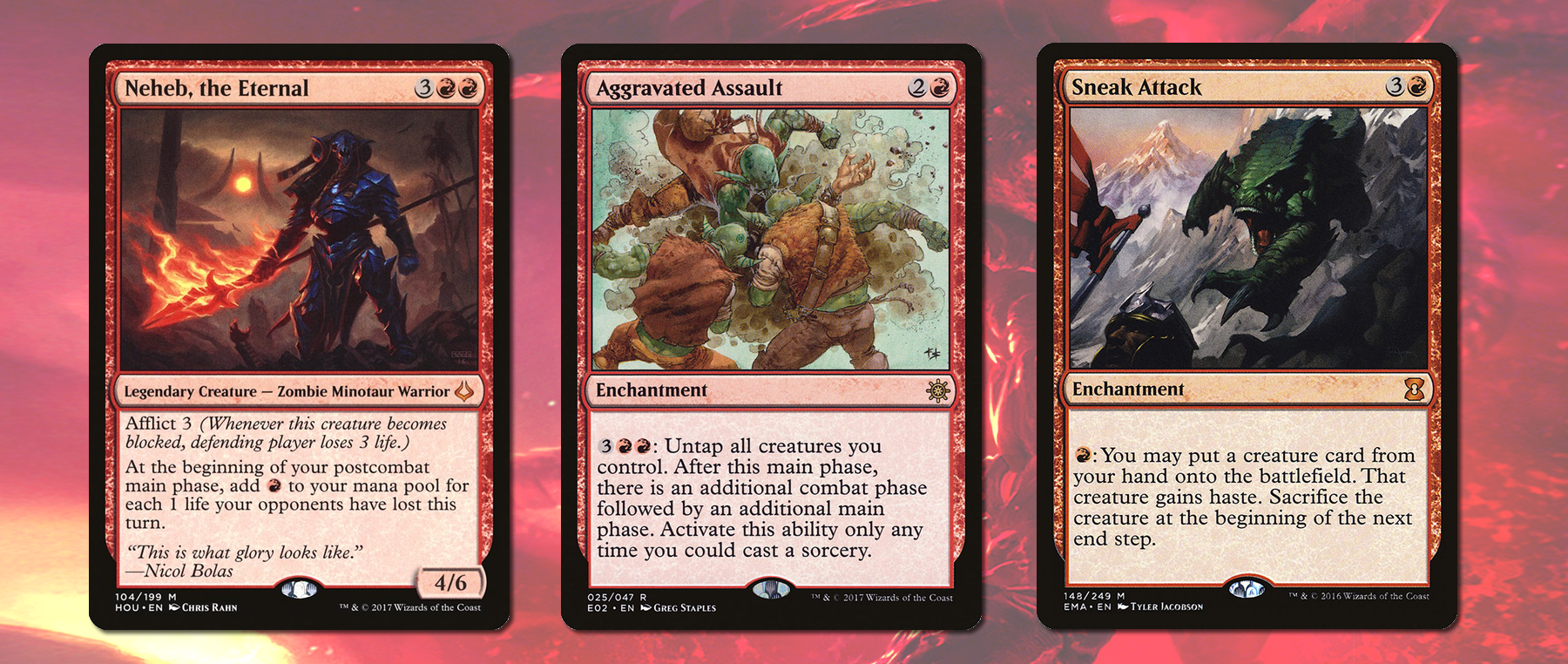
The other “easymode” card in the deck is Sneak Attack. Sneak Attack allows us to drop in lots of creatures for their ETB value, swing in with them, and then get them back later. If we’re set up properly, we can sacrifice them and then replay them with Chainer, or use other cards to get them back. This is a cheap and efficient way to perform our strategy, and I’ve rarely lost a game I’ve resolved this card.
With a deck focused on break-neck speed beatdowns, we’ll often find ourselves in a place where we just need to do just a bit more damage to finish opponents off. For these situations, Cut // Ribbons is perfect. It gets rid of a blocker on the front side, and can drain the life out of our opponents on the other. If we’ve been abusing our life total (as we will be), then Gray Merchant of Asphodel is our repeatable version of this effect that gives us a comfortable out to win games. He’s a backup plan for sure, but one I like having in my back pocket.
Now’s a good a time as any to mention some cards that don’t fit anywhere else. Molten Primordial ends games, and combined with a sacrifice outlet, gives us some removal and damage. Grave Titan is incredible with Haste, giving us four zombies if we attack the same turn. That’s crazy efficient. The final card (that I love playing in this deck) is Etali, Primal Storm. It’s a powerful card, but you have to untap with it to get the trigger. That’s not usually a problem in this deck, so go nuts. You play your extra spells, and you enjoy it. You deserve it.
Shenanigans
Now’s a good point to take stock of our more spicy interaction. An underrated card in this deck is Muck Drubb. This five-mana creature has Flash, and enables us to protect Chainer from single target removal by discarding it to Chainer’s ability and paying the Madness cost. What’s more, as the game progresses, we can buy this back with Phyrexian Reclamation or retrace it—discarding a card in an opponent’s turn and flashing this guy in from the graveyard is a play that will surprise and confound, and can be used politically in order to save not only your own creatures, but your opponents as well. Spicy.
Dualcaster Mage comes at instant speed to be tricksy, and this one’s a doozy. Messing with big splashy spells is the ceiling, but honestly? Copying a ramp spell is still pretty nice. Holding this card for the perfect moment is less important in a deck like Chainer, as we can still cast this from the graveyard on an opponent’s turn provided we have Chainer in play.
One of my new favourite red value cards, Direfleet Daredevil, makes an appearance in this build too. Being able to replay this effect is very strong, and like Dualcaster Mage, gives us access to effects we don’t normally get in our colors.
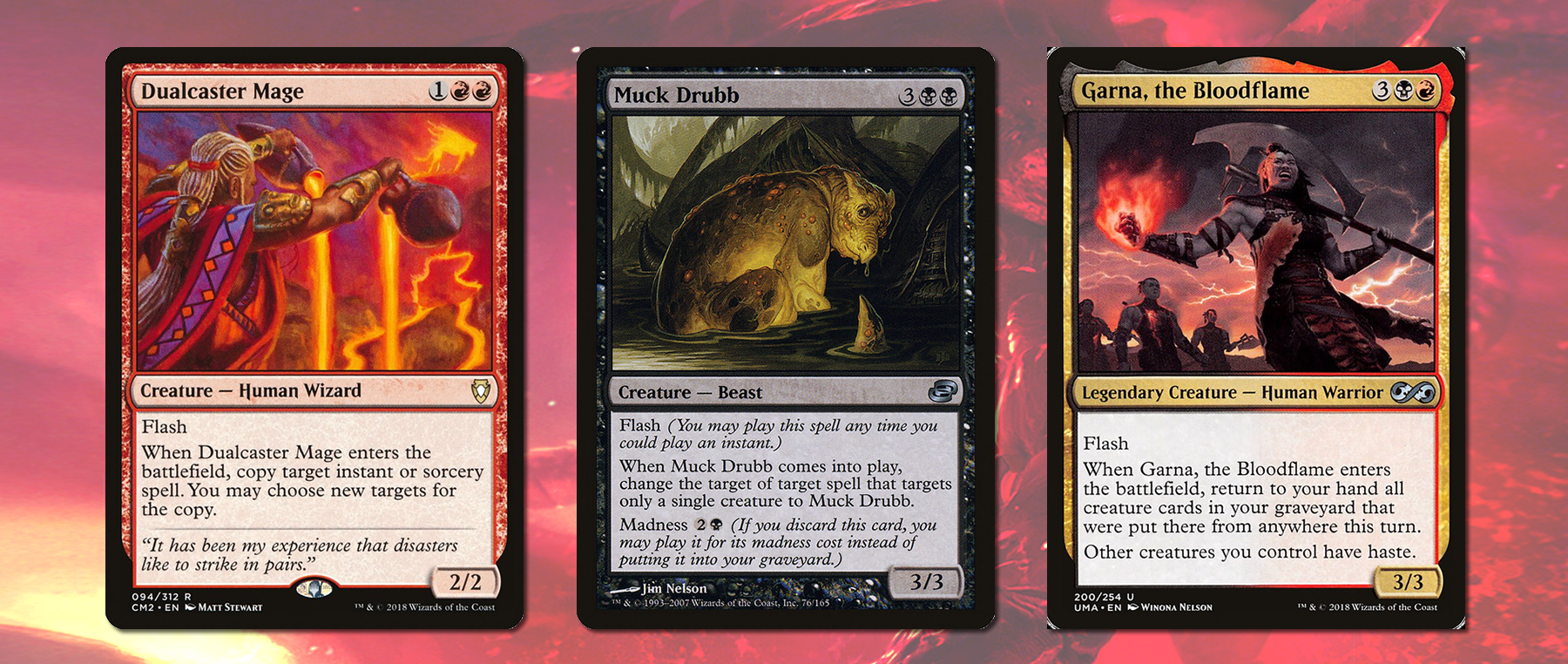
Garna, the Bloodflame does a bunch of work for us at instant speed too. She can re-draw what we lose from boardwipes, recover our Commander from untimely removal, or simply buy-back what we’ve dropped in from a Sneak Attack.
If you enjoy the versatility of instant speed, we have Emergence Zone in the manabase for a one-shot Vedalken Orrery effect.
Removal
If you made it this far, you’ll be wondering where the rest of the creatures are. Well, they’re either removal or recursion. Let’s get through removal first. We’re running Meteor Golem, Ravenous Chupacabra, Plaguecrafter, Inferno Titan, and Ingot Chewer in the creature slots, powerful effects that we can hope to recur. Ingot Chewer is cute, as we can cast it from the graveyard with Chainer for the evoke cost.
For single target removal, we have Terminate, Murderous Cut, Burn Away, Volcanic Offering, and Bedevil. All of these are multi-functional, efficient, or synergise with our deck. We also run Rakdos Charm and By Force for artifact removal, and Chaos Warp to answer problem permanents. For board wipes, we are a little thin, as we want to be in control of the board with creatures. We run Hour of Devastation to get around indestructible, Blasphemous Act for efficiency, and In Garruk’s Wake to finish the game.
Recursion
Recursion in the deck is important. We run one-shot effects Animate Dead, Reanimate, and Beacon of Unrest, which are all capable of recurring our opponent’s threats as well as our own. In addition to these, we run Phyrexian Reclamation, Nim Deathmantle, Feldon of the Third Path, Doomed Necromancer, and Whip of Erebos, which is particularly angled at preserving our life total.
One newer card I’m trying in this build is Backdraft Hellkite. This dragon, coming in usually with haste, allows us to cast instants and sorceries in our graveyard as if they had Flashback until end of turn. Early game, this can re-use Buried Alive, or a removal spell. Late game, it can cascade into big value plays, as we aren’t limited to only casting one of our spells, but as many as we have mana for. I’ve really enjoyed playing with it, and it’s cool to find it a home outside of spellslinger decks.
Gameplay
The deck, as you can tell, wants to concentrate on getting incremental value from recurring cards like Burnished Hart, Solemn Simulacrum, and Dire Fleet Daredevil, all while getting in for hasty damage. Unless the cards fall right, going all in too quickly might leave you wide open, so aiming to play as a midrange deck with big tempo swings is the baseline. Occasionally, you’ll have busted turns, made possible from Aggravated Assault, Sneak Attack, or Garna, the Bloodflame.
This deck is, as I say, aimed for midrange tables. It eschews some of the format staples to both reduce the potency of the deck and feature lesser-played cards.
Some of you reading this will have questioned why certain cards were missed—yup, you thought of Shriekmaw when I mentioned Ingot Chewer‘s evoke—so let’s go over some upgrades and potential maybe cards.
Upgrades
I really like where the deck is positioned right now, but it does skimp on a few more powerful interactions. I’m not intending to reinvent the wheel and make this a combo deck, but here are some choice cards to consider.
Shriekmaw is solid removal, and the evoke cost can be abused much like with Ingot Chewer. Phyrexian Delver, Sheoldred, Whispering One, and Balthor the Defiled are very strong reanimator cards. The former I chose to skip because I didn’t feel like I could stomach losing life too often. Sheoldred is a little overplayed and a removal magnet, and Balthor I feel doesn’t add much to our already hastey engine, though he is undoubtedly strong.
Sepulchral Primordial probably makes the cut over Molten Primordial, but honestly? I don’t own one right now! I think it’s important when deckbuilding, especially when sharing the process, to not edit in cards that the community expects to see just for the sake of it; it’s not very representative of how people budget and build decks, and ultimately doesn’t help the wider community who don’t always have access to everything. Same goes for Disciple of Bolas. If you have one though, definitely play it.
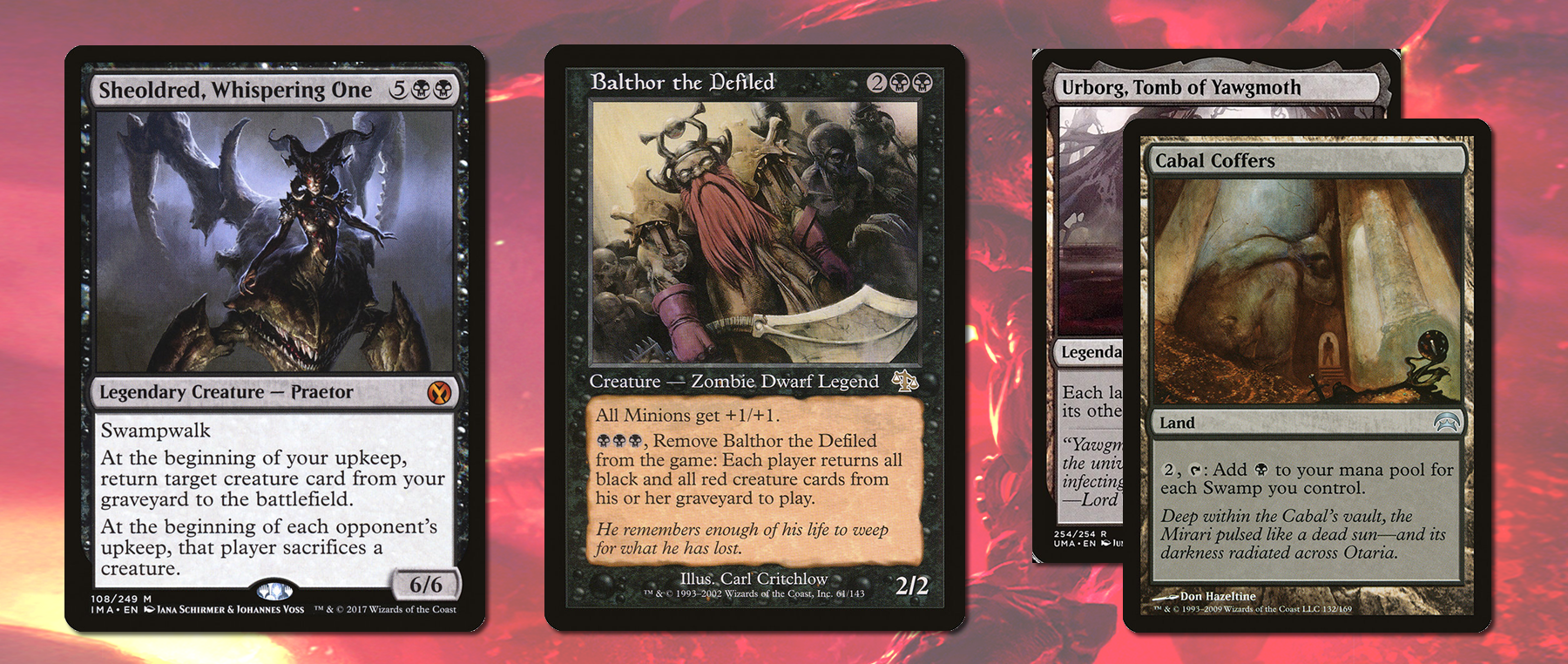
Cards like Entomb, Sidisi, Undead Vizier, Demonic Tutor, and Diabolic Intent all provide greater consistency. Try them if you have them, but I don’t feel like the deck needs them. Likewise, the extra mana from Cabal Coffers & Urborg, Tomb of Yawgmoth wouldn’t go amiss.
Kokusho, the Evening Star drives the deck in the direction of aristocrats—we already have Gray Merchant, and I wanted this deck to be more focused on combat. It could do with High Market, though—a great sacrifice outlet to include.
Finally, Vedalken Orrery could join the deck; playing at instant speed is always great. We don’t miss it too much as we have Haste a lot of the time, but it’s still a cool card.
In Closing
Whew! That was one deep dive. I think it could probably qualify to be part of the series on Recursion, too. I hope it’s given you some inspiration. I like taking different directions than the norm with new Commanders—most of the Chainer lists I’ve seen have been combo-focused or aristocrats. We do sacrifice creatures, but mainly for value!
This deck is super fun, and I really enjoyed the deckbuilding process with it. Hopefully it’s given you some inspiration, and some insight into certain lines of play. You can read the full decklist here. Hit me up on Twitter to continue the discussion!
Kristen is a lover of both Limited and Commander, and can most often be found championing the Boros Legion when called upon to sit down and shuffle up. Based in the UK, she works as a software developer, and her love for the Legion is second only to her appreciation for Lord of the Rings and Mass Effect.


